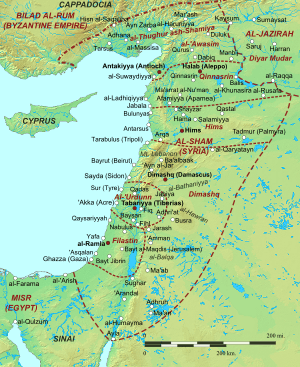Bilad al-Sham
| Bilad ash-Sham بِـلَاد الـشَّـام | |||||
| Province of the Rashidun, Umayyad and Abbasid Caliphates | |||||
| |||||
 | |||||
| Capital | Damascus | ||||
| Historical era | Middle Ages | ||||
| • | Battle of Yarmouk | 636 | |||
| • | First Fitna | 656–661 | |||
| • | Tulunid control | 878–904 | |||
| • | Partition between Hamdanids and Ikhshidids | 940s | |||
| History of the Levant |
|---|
| Stone Age |
| Ancient history |
| Classical antiquity |
| Middle Ages |
| Modern history |
Bilad al-Sham (Arabic: بِـلَاد الـشَّـام Bilād a'š-Šām) was a Rashidun, Umayyad and later Abbasid Caliphate province in what is now the Levant. It incorporated former Byzantine territories of the Diocese of the East, organized soon after the Muslim conquest of the Levant in the mid-7th century, which was completed at the decisive Battle of Yarmouk. The term "Bilad al-Sham" means "land to the north", literally "land on the left-hand" relative to someone in the Hejaz facing east (Bilad al-Yaman (بِـلَاد اليَـمَـن) correspondingly means "land of the right hand").[1][2]
History
The name given to the Levant by the Arab conquerors was Aš-Šām (Arabic: الـشَّـام, "The North").[1][2] The region at the time of conquest was part of the Byzantine Diocese of the East, populated mostly by Monophysite Christian peasants (like the Mardaites) who constituted the bulk of the native population, Greek Orthodox Christian minorities called 'Melchites' or Rûm (Arabic: رُوم, which in that particular context means "Eastern Roman" or "Byzantine"), and by Ghassanid and Nabatean Arabs, besides various non-Christian minorities (Jews, Samaritans and Ismaelite Itureans). The population of the region did not become predominantly Muslim and Arab in identity until nearly a millennium after the conquest. Following the Muslim conquest, Muawiyah ibn Abu Sufyan (602–680 CE) of the Banu Umayyah governed the Syrian region for twenty years, and developed the province as his family's power base. Relying on Syrian military support, Muawiyah emerged as the victor in the First Fitna (656–661) and established the Umayyad Caliphate (661). During Umayyad times, al-Sham was divided into five junds or military districts. The initial districts were Jund al-Urdunn (Arabic: جُـنْـد الْأُرْدُنّ, "Military district of the Jordan"), Jund Dimashq (Arabic: جُـنْـد دِمَـشْـق, "Military district of Damascus"), Jund Ḥimṣ (Arabic: جُـنْـد حِـمْـص, "Military district of Homs"), Jund Filasṭīn (Arabic: جُـنْـد فِـلَـسْـطِـيْـن, "Military district of Palestine"), and later, Jund Qinnasrîn (Arabic: جُـنْـد قِـنَّـسْـرِيْـن, "Military district of Qinnasrin") was carved out of part of Jund Hims. Under the Umayyads, the city of Damascus was the capital of the Islamic Caliphate and Syria formed the Caliphate's "metropolitan" province; likewise, the elite Syrian army, the Ahl ash-Shâm (Arabic: أَهْـل الـشَّـام), formed the main pillar of the Umayyad regime. Syria became much less important under the Abbasid Caliphate, which succeeded the Umayyads in 750. The Abbasids moved the capital first to Kufa, and then to Baghdad and Samarra, all of which were in Iraq, which consequently became their most important province. The mainly Arab Syrians were marginalized by Iranian and Turkish forces who rose to power under the Abbasids, a trend which also expressed itself on a cultural level. Under Harun al-Rashid (r. 786–809). The northern parts of the province were detached to form a new jund, called al-ʿAwāṣim (Arabic: اَلْـعَـوَاصِـم),[3][4] which served as a second line of defence against Byzantine attacks, behind the actual frontier zone of the Thughur. From 878 until 905, Syria came under the effective control of the Tulunids of Egypt, but Abbasid control was re-established soon thereafter. It lasted until the 940s, when the province was partitioned between the Hamdanid Emirate of Aleppo in the north and Ikhshidid-controlled Egypt in the south. In the 960s the Byzantine Empire under Nikephoros II Phokas conquered much of northern Syria, and Aleppo became a Byzantine tributary, while the southern provinces passed to the Fatimid Caliphate after its conquest of Egypt in 969. The division of Syria into northern and southern parts would persist, despite political changes, until the Mamluk conquest in the late 13th century.
See also
References
- 1 2 Article "AL-SHĀM" by C.E. Bosworth, Encyclopaedia of Islam, Volume 9 (1997), page 261. See also Name of Syria.
- 1 2 Salibi, K. S. (2003). A House of Many Mansions: The History of Lebanon Reconsidered. I.B.Tauris. pp. 61–62. ISBN 978-1-86064-912-7.
To the Arabs, this same territory, which the Romans considered Arabian, formed part of what they called Bilad al-Sham, which was their own name for Syria. From the classical perspective however Syria, including Palestine, formed no more than the western fringes of what was reckoned to be Arabia between the first line of cities and the coast. Since there is no clear dividing line between what are called today the Syrian and Arabian deserts, which actually form one stretch of arid tableland, the classical concept of what actually constituted Syria had more to its credit geographically than the vaguer Arab concept of Syria as Bilad al-Sham. Under the Romans, there was actually a province of Syria, with its capital at Antioch, which carried the name of the territory. Otherwise, down the centuries, Syria like Arabia and Mesopotamia was no more than a geographic expression. In Islamic times, the Arab geographers used the name arabicized as Suriyah, to denote one special region of Bilad al-Sham, which was the middle section of the valley of the Orontes river, in the vicinity of the towns of Homs and Hama. They also noted that it was an old name for the whole of Bilad al-Sham which had gone out of use. As a geographic expression, however, the name Syria survived in its original classical sense in Byzantine and Western European usage, and also in the Syriac literature of some of the Eastern Christian churches, from which it occasionally found its way into Christian Arabic usage. It was only in the nineteenth century that the use of the name was revived in its modern Arabic form, frequently as Suriyya rather than the older Suriyah, to denote the whole of Bilad al-Sham: first of all in the Christian Arabic literature of the period, and under the influence of Western Europe. By the end of that century it had already replaced the name of Bilad al-Sham even in Muslim Arabic usage.
- ↑ Le Strange, G. (1890). Palestine Under the Moslems: A Description of Syria and the Holy Land from A.D. 650 to 1500. London: Committee of the Palestine Exploration Fund. pp. 30–39. OCLC 1004386.
- ↑ Cobb, Paul M. (2001). White Banners: Contention in ‘Abbāsid Syria, 750–880. Albany, New York: State University of New York Press. pp. 11–182. ISBN 0-7914-4880-0.
- Aigle, Denise, ed. (2012). Le Bilād al-Šām face aux mondes extérieurs. La perception de l'Autre et la représentation du Souverain [Bilad al-Sam face to outer worlds. The perception of the Other and the representation of the Sovereign] (in French) (1st ed.). ISBN 978-2-35159-197-0. Archived from the original on 2016-03-16. Retrieved January 8, 2013.
